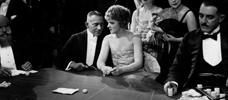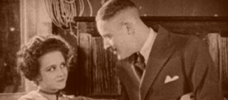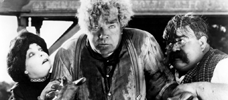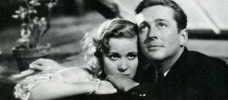Credits
Feature by: Cullen Gallagher, David Carter, Evan Kindley, Ian Johnston, Adam Balz, and Brynn White
Posted on: 23 August 2009
Ambition is a strange rider. Sometimes the horse it picks can’t carry it.
—James Sallis, Cypress Grove
Oh, cursed ambition—to they lures we owe all the great ills that mortals bear below.
—Title-card from Greed
Excavating an Auteur
What remains of an artist, his career, or his work, after having endured so many detours, disappointments, and derailings? Titles changed, credit revoked, productions halted, scenes reshot by other directors, and the humiliation of being thrown off the set of your own movie. These are but a smattering of the setbacks encountered by Erich von Stroheim throughout his directorial career, which began with a bang in 1919 and ended with a whimper in 1933 with a film that bore no mention of his name. All of this makes von Stroheim’s status as an auteur at once obvious and problematic. Few directors before him were as gung-ho about artistry and authorship (his name proliferates the credits of his films, leaving no question as to whom is the true creator); fewer dared to cause the scandals that he did, pushing the buttons of censors and studios past the point of compromise; and no one had their films as distorted (sometimes released incomplete) as Erich von Stroheim.
Even before he began directing, while still struggling for screen-time as an extra and occasionally working behind-the-scenes at the Reliance-Majestic Studios (home to D.W. Griffith), von Stroheim’s meticulous demand for perfection and ceaseless quest for attention were already making him unpopular with his colleagues. But being notorious is better than overlooked, and von Stroheim tried to use this to his advantage. Unfortunately, while being tagged as “The Man You Love To Hate” won him steady acting work as a villainous Hun (or variations thereof), the “hatred” was all-too real when it came to his co-workers and studio executives who had no tolerance for his directorial vision (which was often physically taxing and exorbitantly expensive). While his early films were by-and-large successful, audiences ultimately found his increasingly ubiquitous, unapologetic sexual perversity distasteful. Films about European royalty were supposed to be “pretty,” a word that could hardly be used to describe his sordid characters and their revolting, decadent lifestyles. Bold, overambitious, and effrontery to both the aesthetics and morals of his time, these were precisely the elements that made von Stroheim’s cinema so singularly rich and unprecedented but also doomed his career every step of the way.
No film of von Stroheim’s ever passed from his hands to audiences in its intended form. Only once, for a special preview of the original 9-hour version of Greed, did a film of his even grace the silver screen in a complete, fully actualized version. After he failed to cut it to a length deemed manageable by the studios, it was taken from his hands and cut to roughly 2 hours. However, as if to spite the studios that tried to constrict, mangle, and erase his imprint from the films, the unmistakable presence of Erich von Stroheim continues to assert itself. Ninety years after the premiere of his debut and seventy-six after the release of his unintended, unworthy swansong, the personal and peculiar vision of von Stroheim is clearer and more pronounced than ever.
Mythologies/Mysteries
Much like the lost footage of Greed or The Wedding March, von Stroheim’s background is shrouded in uncertainty and speculation. Partially responsible for this ambiguity is von Stroheim himself, who as much as he desired to be the author of his films also strove to be the author of his biography. Born in Austria in 1885, mysterious circumstances surrounding an alleged fall from grace resulted in his emigration to America, where he landed in New York on November 25, 1909. (This much is confirmed by the United States Department of Justice, Immigration and Naturalization Service.) Work as a traveling salesman took him to San Francisco, and odd jobs and chance encounters landed him in Hollywood, among a rush of persons looking to enter the blossoming film industry.
Rumors of Austrian nobility and military greatness surrounded von Stroheim from the beginning1 and were seemingly corroborated by his on-set behavior, which included self-proclaiming himself an expert on both military regalia (in order to become wardrobe supervisor to Henry Walthall on Ghosts in 1915) 2 and uniforms. The latter secured him a position on John Emerson’s adaptation of Old Heidelberg, for which von Stroheim was responsible for the casting and costuming of the “student corps.” According to biographer (and close friend, which should be taken into account) Thomas Curtiss Quinn, “Each morning the von Stroheim “student corps’ – all of whom had been subjected to a German haircut – would “fall in’ in military fashion on an open stage and stand roll call, inspection, and a rehearsal drill.”3
Even the reoccurrence of certain characters, plots, and settings, in his films seems to suggest a trace of autobiography. Fallen royalty, rising military officers, and counts and princes confined by class and custom (and who are often played by von Stroheim himself) parade throughout pre-World War I Europe (most notably Vienna, the birth place of von Stroheim) with such vivid, precise details and experiences they could only have been lived.
Lived they may have but not by von Stroheim, according to biographer and noted film historian Richard Kozarski. His comprehensive study on the director, The Man You Loved to Hate: Erich von Stroheim and Hollywood, attempts to put to bed many of these rumors concerning von Stroheim’s alleged fall from grace and aristocratic background. “It is known now that the man was not the émigré heir of a noble line, but the eldest son of a Jewish hatter. So his films of imperial decay are no longer read as the gossipy re-creations of a renegade Hapsburg, but the fantasy construction of someone on the outside looking in.” 4 Nothing signals this fictional rise-to-greatness better than his name change upon passing through Ellis Island. Erich Oswald Stroheim, as he was born, rechristened himself “Erich Oswald Hans Carl Maria von Stroheim.” 5 A coronation fit for royalty, indeed, and a duty he fulfilled from that day forward.
Blessed Ambition, Cursed Ambition
If Von Stroheim is like Icarus, punished for his lofty aspirations, then D.W. Griffith is his Daedalus, the father who created the wings that would destroy his own son. Von Stroheim’s education on the sets of Griffith’s Birth of a Nation and Intolerance formed the basis for his own understanding of cinema. “I worshipped D.W. Griffith the way that someone can worship the man who has taught him everything,” Von Stroheim later wrote, “who has lavished the treasures of genius on him without holding back. He was the greatest of his day.” 6
Traces of Griffith’s signature style are present throughout von Stroheim’s work. The presentational mise-en-scene that privileges both the actor’s expression and the obsessively, painstakingly detailed sets; poetic (sometimes excessively so) title-cards; idyllic, romantic interludes that off-set an otherwise realist aesthetic; close-ups that reveal the character’s soul (for Griffith often signs of purity, for von Stroheim corruption); and a dexterous use of montage to maneuver around a set, or to cross-cut different scenes for dramatic effect. Von Stroheim often takes Griffith’s stylizations to their furthest extreme, strictly adhering to montage and rarely moving the camera (defiantly against-the-times, as filmmakers were more and more employing expressive lighting and tracking shots).
But he also learned something else from the master: a grand, uncompromising vision that no theater or studio could contain or, more importantly, maintain. Much like Griffith initially planned for Intolerance, von Stroheim had hoped to show his monumental Greed in two parts on consecutive nights, something akin to Wagner’s The Ring of the Nibelung, a series of four connected operas that are intended to be seen consecutively (though they are often divided and performed individually). Neither Griffith nor von Stroheim saw this vision of theirs actualized, but certainly they are two early visions of cinema as a higher art in an age that still saw the medium as decidedly lower.
Baggage and Legacy
Unfortunately, von Stroheim’s films are often considered part of a negative-history, with too much emphasis on the “What Could Have Been” instead of the “What Is.” The missing footage, unrealized projects, and butchered re-edits are things of cinema mythology. The “lost” reels of Greed are like those legends of the abominable snowman or the Loch Ness monster: proof of their existence would be downright incredible, but until they appear they are nothing more than magical speculation, pipedreams that keep our imagination and hope afloat and undying.
More importantly, von Stroheim’s movies need little qualifying or defense, even in their truncated states. There is an honest depravity to his characters, none of whom shy away from, or apologize for, their amoral desires. The philandering wife of Blind Husbands and the duplicitous seducer of Foolish Wives are certainly a world away from the True Heart Susies of D.W. Griffith or the Pollyannas portrayed by Mary Pickford. And by the time The Wedding March rolls around, divisions of moral/immoral are completely broken down: von Stroheim’s Prince Nicki and Fay Wray’s waif Mitzi, the sole symbols of pure love, are as corrupt and perverse as anyone in their respective debauched milieus.
And regardless of studio interference, his filmography is acutely coherent, with noticeable themes re-appearing in film after film. Beginning with his fourth film, Merry-Go-Round, we can see the development of what we can call a “master narrative” which von Stroheim will repeatedly turn to in all but two of his subsequent films. An aristocratic heir finds himself caught between duty (often symbolized by a pre-arranged marriage) and his love for a lower-class girl (a sign of restorative purity who offers the possibility of absolution for the heir’s debased morality). This plot is picked up again in The Merry Widow, The Wedding March, and Queen Kelly. The roots of this unrequited compulsion perhaps lie in von Stroheim’s real life marriage to Margaret Knox, an older and upper-class woman, which began when von Stroheim (employed as a waiter) spilled a bowl of soup on his customer and ended due to economic and class pressures. Von Stroheim could neither make enough money to support them both, nor could find any job that would please Margaret’s status-conscious family.7
Locales and set-pieces figuratively unite the physical landscape of this “master narrative.” The lovers often meet at public spectacles where the classes intermingle, such as the carnival or the Corpus Cristi parade; and blossoming orchards (whether real or recreated) provide escape from the pressures of their class-specific milieus. Within the frame, von Stroheim frequently uses animals (dogs, cows, and devil-horned goats) to symbolize the characters’ impulse-driven actions. In general, his compositions are notable for their extreme realism (whether it is the actual Mojave Desert or his impeccable recreation of Monte Carlo), which Andrew Sarris views as a sign of things to come. “[Von] Stroheim’s realism anticipated the sound era in that he established a sense of milieu more through composition than through montage, and also in that he created characterization less through pantomime than through contextual detail.”8 An ironic and astute observation, considering many thought that von Stroheim’s perceived lack of style was decidedly “behind the times.”
The Martyr You Love to Hate?
In an interview published in the wake of Blind Husband’s success, von Stroheim looks back, almost detachedly, on the hard road that he mistakenly thought was behind him. “Struggles are all right to look back upon, but so far I derive little pleasure in contemplating mine, they are still too recent to have gained any glamour.”9 And they would continue to be “recent” for the duration of his career in film, which eventually turned its focus from directing to solely acting.
Much like what would later happen with Orson Welles, von Stroheim is alternately looked at as a martyr for cinematic art and a monomaniac, a Tinseltown Ahab, if you will. As reactionary as the dichotomy is, there is some truth to both sides. From Blind Husbands to Queen Kelly, his visions only became grander (more expansive narratives, more complex characters), as though the fiascos on each previous film only fueled his ambitions for the next picture even more. (Perhaps this explains the reoccurring “master narrative” as an attempt to not only perfect, but actually produce, the story as he envisioned it.) At the same time, his productions were irrefutably unreasonable: the shooting record for Queen Kelly reports days as long as 23 hours, with only a few hours rest before the crew was on call for the next day’s shooting; his budgets would go tens, if not hundreds, of thousands of dollars over their projections; and shooting schedules would likewise grow longer and longer still, occupying actors and studio space and holding up other productions.
Such a duality, however, inevitably falls short of defining von Stroheim, his greatness, his failings, and everything in between. If we are to look at him as something more than a “might have been” or a victim to either his own vision or the studio’s lack thereof, then we must leave behind the budget reports, the battle cries, and the rumors both false and true. Instead, we must turn to the films themselves, for it is in them that von Stroheim invested himself wholly. They are the reason for the controversy, the celebration.
Of his nine films, seven and a half survive and are available to screen in the versions that were originally released (and in some cases, such as with Foolish Wives and Greed, restored with footage initially cut and/or censored). They are, in chronological order: Blind Husbands in 1919; Foolish Wives in 1922; Merry-Go-Round in 1923 (from which he was removed as director and replaced by Rupert Julian); Greed in 1924; The Merry Widow in 1925; The Wedding March in 1928 (only the first half of The Wedding March remains: its second half, The Honeymoon, perished in a fire never having been released in the United States at all)10; Queen Kelly in 1929 (which, because it was never finished, never received proper distribution in its day); and Hello, Sister! in 1933 (originally titled Walking Down Broadway, we only have what audiences saw back in 1933: a mongrel version that includes scenes re-shot by several other directors mixed in with von Stroheim’s original footage; his name did not appear in the final credits). As far as we know, no print of The Devil’s Pass Key, his second film, exists at all.
Each film has its own story, its own merits, its own flaws. Some call his style crude, yet there is a bluntness about his unadorned images, distracted neither by camera movement nor overtly artificial lighting, as though contained within the frame is some distilled truth, raw and confrontational. He was a cynical romantic, concerned with destroying an idealized romanticism that promoted righteousness and redemption: the upper-classes were not models of perfection, nor the lower classes beacons of hardworking respectability. His worldview was decidedly darker, filled with exploiters and exploited of all classes. Beneath the veneer of pre-World War I imperial Europe was a void of immorality as ugly as the surface was pretty. In von Stroheim’s eye, no one was exempt from the depravity: it was all consuming. His surviving films are a chronicle of an era of decaying morals, and characters who struggle – and occasionally succeed – to transcend its vice-like grip; and his career is a testament to the power of films to persevere economic, artistic, and moralistic constrictions. To survive, and to be seen.
Introduction by Cullen Gallagher
- Maude S. Cheatham, “Erich von Stroheim: The Miracle,” Motion Picture Classic (January 1920) 34. ↩
- Thomas Curtiss Quinn, Von Stroheim (New York: Farrar, Straus and Giroux, 1971) 47. ↩
- Quinn, 49-52. ↩
- Kozarski, The Man You Loved to Hate: Erich von Stroheim and Hollywood (Oxford: Oxford U.P., 1983) viii. ↩
- Kozarski, 3. ↩
- Erich Von Stroheim, “Grand Illusion: My First Meeting with Renoir” (The Museum of Modern Art, Film Study Center). ↩
- Kozarski, 8-12. ↩
- Andrew Sarris, The American Cinema: Directors and Directions 1929-1968 (Chicago: U. of Chicago Press, 1968) 112. ↩
- Cheatham, 35. ↩
- Kozarski, 195. ↩
By Cullen Gallagher, David Carter, Evan Kindley, Ian Johnston, Adam Balz, and Brynn White ©2009 NotComing.com
Reviews
-

Blind Husbands
1919 -

Foolish Wives
1922 -

Merry-Go-Round
1923 -

Greed
1924 -

The Merry Widow
1925 -

The Wedding March
1928 -

Queen Kelly
1929 -

Hello, Sister!
1933
We don’t do comments anymore, but you may contact us here or find us on Twitter or Facebook.



